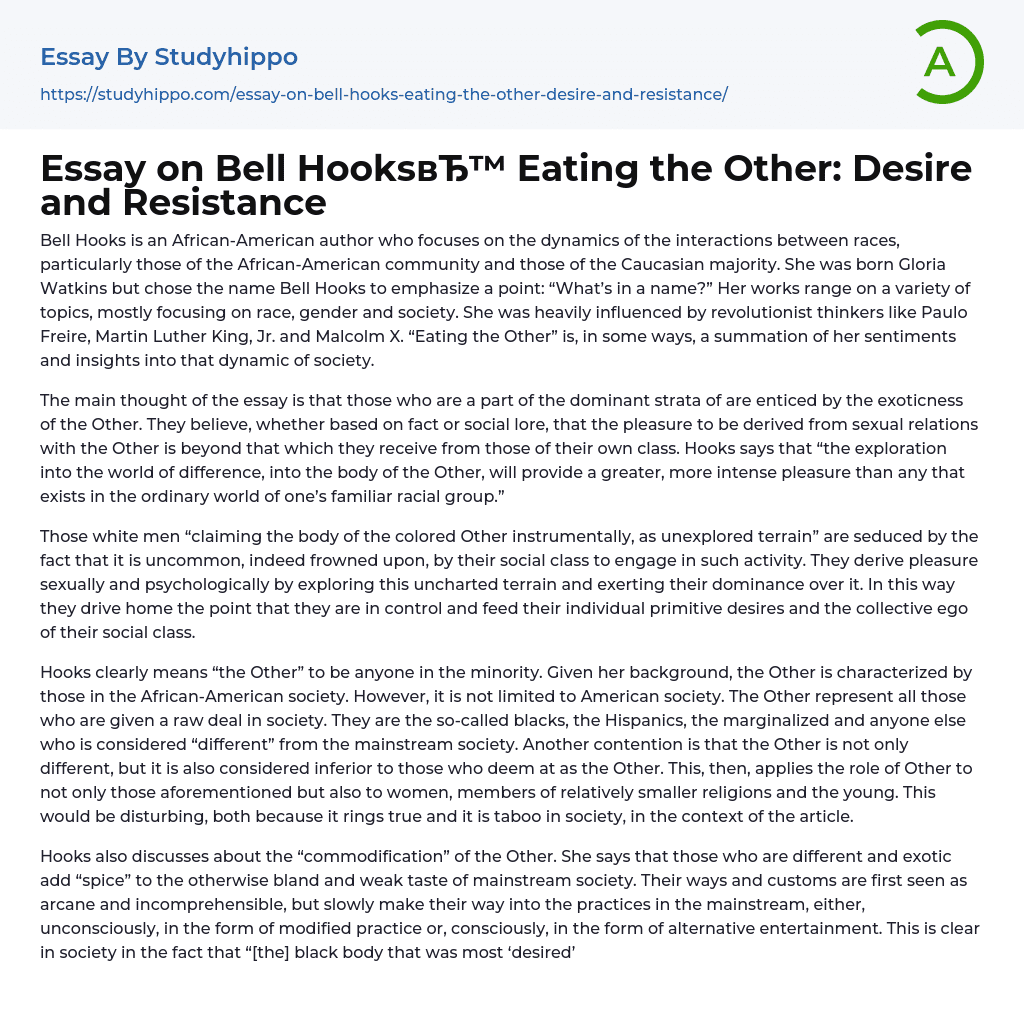

Essay on Bell Hooks Eating the Other: Desire and Resistance
Bell Hooks is an African-American author who focuses on the dynamics of the interactions between races, particularly those of the African-American community and those of the Caucasian majority. She was born Gloria Watkins but chose the name Bell Hooks to emphasize a point: “What’s in a name?” Her works range on a variety of topics, mostly focusing on race, gender and society. She was heavily influenced by revolutionist thinkers like Paulo Freire, Martin Luther King, Jr. and Malcolm X. “Eating the Other” is, in some ways, a summation of her sentiments and insights into that dynamic of society.
The main thought of the essay is that those who are a part of the dominant strata of are enticed by the exoticness of the Other. They believe, whether based on fact or social lore, that the pleasure to be derived from sexual rel
...ations with the Other is beyond that which they receive from those of their own class. Hooks says that “the exploration into the world of difference, into the body of the Other, will provide a greater, more intense pleasure than any that exists in the ordinary world of one’s familiar racial group.”
Those white men “claiming the body of the colored Other instrumentally, as unexplored terrain” are seduced by the fact that it is uncommon, indeed frowned upon, by their social class to engage in such activity. They derive pleasure sexually and psychologically by exploring this uncharted terrain and exerting their dominance over it. In this way they drive home the point that they are in control and feed their individual primitive desires and the collective ego of their social class.
Hooks clearly means “the Other” t
be anyone in the minority. Given her background, the Other is characterized by those in the African-American society. However, it is not limited to American society. The Other represent all those who are given a raw deal in society. They are the so-called blacks, the Hispanics, the marginalized and anyone else who is considered “different” from the mainstream society. Another contention is that the Other is not only different, but it is also considered inferior to those who deem at as the Other. This, then, applies the role of Other to not only those aforementioned but also to women, members of relatively smaller religions and the young. This would be disturbing, both because it rings true and it is taboo in society, in the context of the article.
Hooks also discusses about the “commodification” of the Other. She says that those who are different and exotic add “spice” to the otherwise bland and weak taste of mainstream society. Their ways and customs are first seen as arcane and incomprehensible, but slowly make their way into the practices in the mainstream, either, unconsciously, in the form of modified practice or, consciously, in the form of alternative entertainment. This is clear in society in the fact that “[the] black body that was most ‘desired’ for its labor in slavery and it is this body that is most represented in contemporary popular culture as the body to be watched, imitated, desired, [and] possessed.”
All in all, Hooks’ views, as expressed in “Eating the Other”, is the extremist view of the mainstream’s need to exert dominance over those that they deem different, and by association, inferior. The Other, for Hooks, is
the common African-American who endures White America’s arrogance. They are repeatedly faced by being reduced into instruments that make society “more exciting” for those in the mainstream, something fun but not necessarily alive.
- Healthy Eating essays
- Eating Disorder essays
- Values of Life essays
- Ethical dilemma essays
- Normative Ethics essays
- Virtue Ethics essays
- Belief essays
- Deontology essays
- Moral essays
- Virtue essays
- Work Ethic essays
- Feminism essays
- Animal Rights essays
- Animal Testing essays
- Bullying essays
- Abortion essays
- Abuse essays
- Immigration essays
- Poverty essays
- Human Rights essays
- Inequality essays
- Violence essays
- Torture essays
- Crash essays
- Assault essays
- Racism essays
- Prejudice essays
- Controversial Issue essays
- Cyber Bullying essays
- Women's Suffrage essays
- Women'S Rights essays
- Women Empowerment essays
- Sojourner Truth essays
- Bullying In Schools essays
- Pro Choice essays
- Pro Life essays
- Should Abortion Be Legal essays
- Against abortion essays
- Abortion Debate essays
- Abuse Support essays
- Child Abuse essays
- Alcohol Abuse essays
- Physical Abuse essays
- Sexual Abuse essays
- Substance Abuse essays
- Migration essays
- Human Migration essays
- Illegal Immigration essays
- Immigrants essays
- Refugee essays



